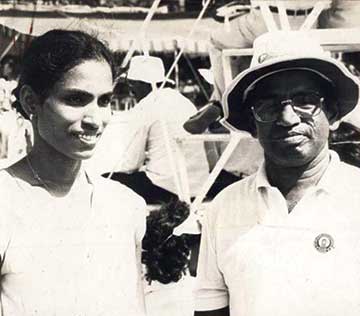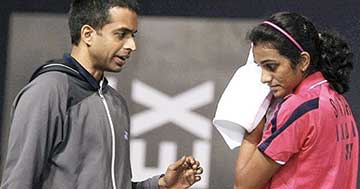Subha Das Mollick
P T Usha had O.M. Nambiar, P.V. Sindhu has Pullela Gopichand, Mary Kom has Ibomcha Singh and Arjuna had Dronacharya. What is the role of a coach in a person’s sporting career? What does a coach do to bring out the best in a sportsperson? A sports journalist once commented, “Usha was a natural athlete. Coach O. M. Nambiar moulded her into one of the all-time greats of Asian athletics.” P.V. Sindhu’s coach Pullela Gopichand commented about his student, “The most striking feature in Sindhu’s game is her attitude and the never-say-die spirit.” An eight-year-old Sindhu had decided to be a badminton player when she saw Pullela Gopichand win the 2001 All England Open Badminton Championship. Soon after, she joined Gopichand’s Badminton Academy and travelled a distance of 56 KM from her home everyday to report for coaching on time.

However, the primary goal of a coach is to develop players, to give individual attention to each player, identify his/her strengths and weaknesses vis a vis the sport, so that the strengths can be perfected and weaknesses overcome through rigorous practice. Attaining perfection is as much a physical challenge as it is mental. Thus a good coach is not only good at his sport, he is also a psychologist, a thought reader, who can understand the young player’s bent of mind and keep his/ her motivation level high. A good coach has to have faith in his ward. If the coach believes in the player he is nurturing, the player will believe in herself. The coach’s responsibility does not end in creating a good player. He has to create a good sportsperson who can stand up to adversities and take on unforeseen challenges. Thus a coach has to set long-term goals for himself and his wards. To fulfil these long-term goals, the coach has to draw up strategies. He cannot rely on formulaic strategies. Every student is a unique challenge to the coach and he has to draw up a unique strategy for every student.
P.V. Sindhu once said in an interview, “About three months before Olympics, I lost in the pre-quarter finals of an Australian Open Championship. My coach told me, ‘Enjoy here. After going back it is going to be really tough.’ After our return he made me sign on a paper, ‘No sugar and no phone for the next eight months’.”
“Special tournaments need special preparation,” quipped Gopichand. “I did it not only for Sindhu in 2016, but I had done the same thing for Saina in 2012.”

A coach, by default, is a good player. But a good player is not necessarily a good coach by default. A coach is driven and a driver; observant and patient, unselfish yet assertive and most importantly, a little self-effacing. A coach cannot have a big ego. He has to listen to others and treat his shishyas as his equals. A coach cannot hanker for the limelight of the sporting arena. His place is behind the arena.
A coach has to nurture a number of students and ensure that no student feels neglected or discriminated against. It requires tact and diplomacy to explain to the students that each one is different, that all the championships are not meant for everybody.
Dronacharya, on whose name the best coach’s award is given every year, was also not free of favouritism. Arjuna and his own son Ashwathhama were his favourite students. To keep Arjuna’s supremacy in archery he asked Eklavya to give his right thumb as guru dakshina. Even today Dronacharya is criticized for this untoward behaviour.
It takes superhuman will to rise above such human follies. A great coach is almost a superman. He has to maintain his moral, mental and physical fitness for years, in order to nurture generations of sportsmen.
In both the Indian epics, coaches have played pivotal roles. Sage Viswamitra taught archery to Prince Rama and took him to Mithila to attend Sita’s swayamvara. Thus was set off the chain of actions that led to the unfolding of the epic narrative. In Mahabharata, Arjun was, in many ways, a creation of Dronacharya. The students that these gurus took under their wings, lived in the gurukuls or the academies opened by the gurus and the gurus took responsibility for holistic growth of their students. The gurukuls provided an immersive and congenial environment for all round development.
Days have changed and modern gurus have to cope with multifarious distractions for themselves and their students. Distractions come in the guise of food and lifestyle. Coaches have a tough time keeping the students on the right track. Students showing promise early in their life are faced with tough choices. They have to strike a balance between academics and sports. They are too young to make mature career choices. They are influenced by their parents. Coaches too come under parental pressure. Sometimes parents want to wean away a promising student from sports and convince her to opt for a safer career. Sometimes parents want quick results in terms of wins, trophies, medals and scores. They want quality for their kids, but they mistake wins for quality. Coaches have to convince the parents that losing is more important than winning. A loss brings the weaknesses to surface and helps the player perfect his skill. The tussle between winning/scoring and development gives rise to a conflict between long-term and short-term goals.
A good coach has to be a relentless critic. Even as he encourages his student to perform and keeps her morale high, there is no shying away from being a tough taskmaster. The coach cannot allow his student to lapse into complacency. After every success, every win, every medal won, the coach has to raise the bar a notch higher. In today’s day and age, every game can be video recorded and later played back in slow motion, frozen at the strategic moments and analyzed threadbare. Thus, coach and student can together review the performance and make notes for improvement.

In the Mahabharata, the coach and his favourite student were adversaries in the battlefield of Kurukshetra. Dronacharya, as the commander in chief of the Kauravas, was instrumental for the death of Arjuna’s son Abhimanyu. Arjuna was enraged beyond measure and vowed to avenge his son’s death. Drona lined up the entire Kuru army, with millions of its soldiers in front of Arjuna to thwart his mission. But Arjuna exhibited his full prowess, and by the end of the day killed more than a million warriors single-handedly.
Perhaps Dronacharya was secretly pleased to witness Arjuna’s invincibility. Perhaps the biggest reward for a coach is to be defeated at the hands of his shishya.
References
• www.mahabharataonline.com
• https://youtu.be/R4k9z3hQJmc
• https://youtu.be/tvADU5ty5zI
The author is a media teacher and a documentary filmmaker. As founder secretary of Bichitra Pathshala, she explores and promotes ‘learning with moving images’. She can be reached at subha.dasmollick@gmail.com.
